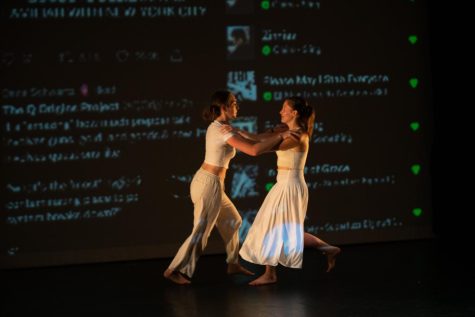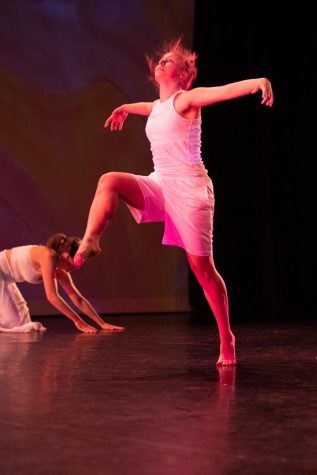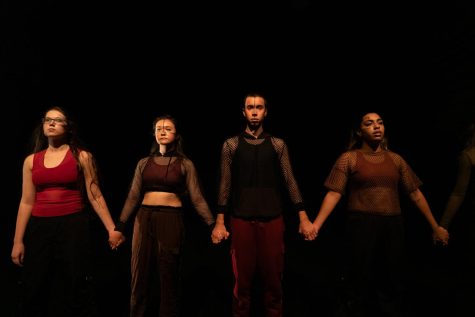“Ghost Pixcells” in review
November 4, 2021

Bodies are not easy things to have. They bear the weight of our environments, our emotions, our habits, relationships, injuries, social conventions—anything and everything we do, external or internal, demands something from them, weakens them, strengthens them, transforms and modifies them. As a result, it’s no mystery why we’re so enamored by the art of dance. It’s nebulous, but the poetic marriage of emotion, physicality and performance feels more dependent on nebulousness than virtually any other art form. And what could be more human than surrendering to mystery?
Over the weekend, “Ghost Pixcells” danced its way into Harper Joy Theater. A poetic meditation on a sort of collective rebirth from a cocoon of digital isolation, the three discrete sections each presented a distinct physical, aural and emotional perspective on our bodies—their role in that rebirth and their place in our new world.
The first piece—“egress and retreat, to the concave altitudes,” choreographed by Associate Professor of Dance Reneé Archibald—began in darkness. Gradually, individual warm lights revealed a troupe of dancers dressed in the muted colors of late-fall foliage. Surprisingly for a dance piece, sound and color were the primary stars here. The piece was broken up into a series of brief snippets, which were marked by momentary returns to total darkness, all underscored by a constant droning soundscape that sounded like a push vacuum layered atop a jet engine layered atop a set of windchimes. Archibald’s choreography, subdued and hypnotic, consisted of small bursts of subtle movement with occasional moments of harmonious unison that hit with the same fluttering warmth as a hug that sneaks up on you from behind.
Tension gradually rose as the hum grew ever fuller, and in turn the stage grew more vast—no longer was the lighting selective and sectioned off, but it revealed the stage near entirely. As the hum abruptly stopped—a jarring shift, as the sound had grown so hypnotic its presence became nearly inextricably linked with the physical space—all that was left was the sound of breathing, and soon even that was swallowed by darkness.

Senior Lecturer of Dance Peter de Grasse’s piece, “ease up (the runningmachine),” made for a sharp tonal departure from the serenity and selectivity of “egress.” Natural colors gave way to harsh light, cacophonous and indecipherable spoken-word and shrieks that filled the room with an ominous, depressive energy. The stage was lit from end to end in blue and green, leaving no corner of the space up to the imagination. The air was raw, jagged. It began with a lifeless body being dragged offstage.
There was a spectrum to the choreography, with animalism on one end and a sort of synthetic restraint on the other, and humanity lost somewhere in the middle—the dancers wore makeup that subtly gave their faces the impression of being pieced together from machine parts, and at times their movements were subtle, verging on inhuman. At times the performers would simply run from one end of the room to another, back and forth, round and round, as though they were either trying to purge pain from their physical bodies or break free of the physical space. There came a point later where this suddenly gave way to guttural, animalistic roars, with the dancers dropping to all fours in a display of primal ferocity.
The final piece, “Untitled Terrain,” choreographed by guest artists Kathleen Kelley and Christian Von Howard, boasted an impressive multimedia setup that featured ballet-inspired choreography and an abstract, dynamic video piece that later acted as a sort of centerpiece to the production. All-white costumes blended with sweeping, cool lighting, creating an atmosphere that was just as rapturously hypnotic as the first piece, though the visual and aural elements behind that hypnotism were somewhat in tension with one another. The choreography evoked a similar serenity to that of the first piece, while the music—a rhythmic and dissonant string piece—underscored the visuals with a sense of edge-of-your-seat thrill.
Gradually, the amorphous black and white on the screen gave way to a dizzying triptych of recorded cell phone screens, endlessly scrolling and scrolling through social media feeds and Spotify playlists, the visuals suddenly matching the frenetic energy of the score. As one of the dancers suddenly brandished a digital camera and began filming the movements of their fellow performers, the screen began displaying a live video feed. The choreography suddenly took on an entirely new level of dynamism, as the camera roamed up and down the performers’ bodies, following the thrusts of their arms and the rolling of their necks, catching the stage lights occasionally casting their forms into silhouette.

While the three pieces had very little in common on the surface, they were united by a couple major through-lines—namely a sense of isolation and rebirth, and the tension that exists in the space between the two. It’s so beautifully apt that this is Whitman’s first dance show since the beginning of the pandemic, and in all honesty, it seems like we could all stand to take in a wonderfully weird, poetic piece of performance art right now. Our relationship to our bodies has undergone a bit of a profound recalibration lately. “Ghost Pixcells” understands that at a very intimate level and seems to be reminding us that that’s okay, that wherever we happen to be in our relationships with our physical selves is okay. That it’s all just one big mystery.





